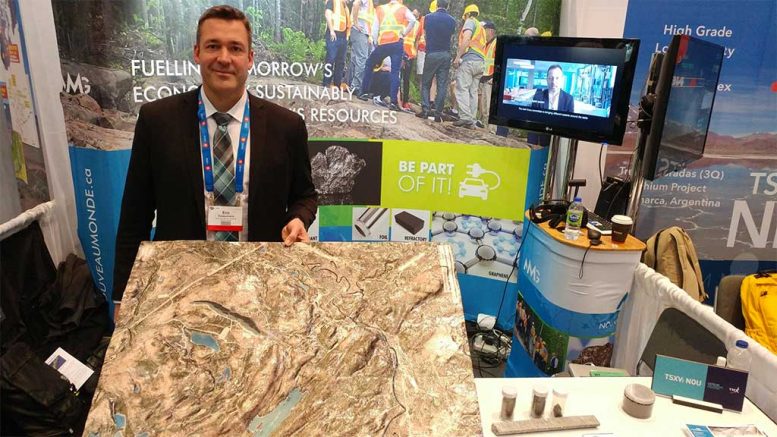Nouveau Monde Graphite (TSXV: NOU) wants to build an all-electric, open-pit mine that will have a carbon neutral footprint at its Matawinie project in Quebec, 120 km north of Montreal.
A feasibility study on turning the natural flake graphite project into an all-electric operation should be ready before the end of 2018.
“We don’t know of any other all-electric open-pit mine, so it will be the first project of its kind,” Eric Desaulniers, the company’s founder, president and CEO, told The Northern Miner. “Hopefully we’ll be the first to build one … construction is planned to start in the middle of 2020.”
In second-half 2017, Nouveau Monde brought together a committee of international experts: ABB Inc., Doppelmayr Canada, Met-Chem Canada Inc./DRA, Medatech Engineering Services Ltd. and SNC-Lavalin.
Met-Chem/DRA, a Montreal engineering firm, will lead the feasibility study.

Sampling at Nouveau Monde Graphite’s Matawinie high-purity, flake graphite deposit north of Montreal, Quebec. Credit: Nouveau Monde Graphite.
Desaulniers says converting the project to an all-electric model would cost slightly more in initial capital expenses than the $180.8 million (including a $22.1-million contingency) estimated in an October 2017 prefeasibility study of a traditional operation. But the company will be eligible to apply for grants from the Quebec government, he says. In addition, the operating expenses of an all-electric mine likely would be lower than the $28 million per year — or $539 per tonne of concentrate — estimated in the prefeasibility study.
“It will be about $20 million more in capex to go all-electric, but opex should be much lower, and we can recover that money within 10 years,” he says. “There are a lot of grants for electrifying mines in Quebec — the Quebec government wants to go all electric everywhere — so we’re confident that we can get some grants. It’s good not only for our mine but also for the province to develop the expertise and convert mines to electric, and then export that knowledge everywhere in the world.”
The 2017 prefeasibility study forecast annual average production of 52,000 tonnes of graphite concentrate over a 27-year mine life, putting the after-tax payback at just over 2.5 years. The project has an after-tax net present value of $297.2 million at an 8% discount rate, and a 25.9% after-tax internal rate of return.

Core racks at Nouveau Monde Graphite’s Matawinie project in Quebec. Credit: Nouveau Monde Graphite.

A worker cutting core at Nouveau Monde Graphite’s Matawinie project in Quebec, 120 km north of Montreal. Credit: Nouveau Monde Graphite.
The study also considered an average run-of-mine feed of 4,850 tonnes per day for five days a week.
The prefeasibility study only considered the pit-constrained resource of the West Zone, which has indicated resources of 32.9 million tonnes grading 4.50% graphitic carbon (Cg) and 0.2 million tonnes of 4.84% Cg in the inferred category.
“The prefeasibility study was a basic, traditional project with traditional trucks … so we worked with ABB and a bunch of other people to redo all of this with an electric concept, converting trucks to electric,” Desaulniers says. “ABB is not involved in predevelopment stage projects, but they wanted to develop this concept of all-electric mines, which is the same technology as they use for bus stations, and Medatech did all the conversion for Goldcorp’s Borden mine.”

Bagging graphite from the crusher as part of a 12-tonne bulk sample in 2015 at Nouveau Monde Mining’s Matawinie graphite project in Quebec, 130 km north of Montreal. Credit: Nouveau Monde Mining.
Desaulniers notes that going electric is good for the project because it is on the grid and just two hours outside of Montreal. “It’s easier to do than it would be for a company like Stornoway Diamond in the middle of Quebec, for example,” the CEO says.
In addition, because the company will make battery material, it made sense to turn the project into an all-electric one, he says.
Desaulniers notes that because the proposed work schedule of the mine consists of a 12-hour shift five days a week, the company can charge its fleet of trucks, excavators and bulldozers overnight, as well as opportunistically during the day.
“We’d use opportunistic charging whenever a vehicle is at a planned stop,” he explains, adding that in a 15-second charge you can get 1 kilowatt hour of electricity. Some of the vehicles can also be charged during braking, he says, for example, while they are driving down a pit slope. As for the electric crusher, 6 kilowatt hours can be had from a 90-second charge.
“It’s still too early days to put any hard figures on the charging, but it gives you an idea of how this opportunistic charging would take place,” he says. “One of the questions we have is: ‘Which trucks should we convert? Caterpillar, Komatsu, John Deere or Daimler?’ We’re negotiating with them to do the conversions.


Be the first to comment on "Nouveau Monde plans all-electric mine in Quebec"